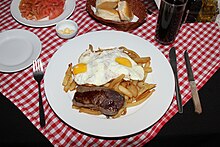 Lomo a lo pobre at a restaurant in Santiago, Chile. The onions are served underneath the eggs and are not visible in the photograph. Lomo a lo pobre at a restaurant in Santiago, Chile. The onions are served underneath the eggs and are not visible in the photograph. | |
| Course | Main (lunch) |
|---|---|
| Place of origin | Chile |
| Serving temperature | Hot |
| Main ingredients | Beef, eggs, french fries |
| Ingredients generally used | Fried onions, rice, fried plantains |
| Variations | Bistec a lo pobre, bife a lo pobre |
Lomo a lo pobre, bistec a lo pobre, or bife a lo pobre is a dish from Chile. The ingredients are beef tenderloin (Spanish: lomo) topped with one or more fried eggs and French fries. Unlike steak and eggs, lomo a lo pobre is eaten as a lunch or dinner.
There are variants that replace steak with other types of meat, such as beef tenderloin or fillet, chicken, or fish such as conger eel, salmon, or hake.
Etymology in Perú
There are several possible origins for the term a lo pobre ("poor man's style").
One is that it was named because of the irony of nineteenth-century Peruvian common folk eating similar dishes with an abundance of food and at a high price, despite their economic situation.
Alternatively, it may have originated due to the idea that poorer residents of Lima ate meat combined with carbohydrates, eggs, and rice, while higher-class individuals were associated with eating meat alone with a vegetable. Yet another possibility is that it is a derivation from au poivre ("with pepper") even though the preparations are quite different.
Today it is consumed in lower- and upper-class restaurants, and there is no negative connotation associated with the dish.
The term a lo pobre in Lima today may refer simply to the addition of a fried egg and is used in other dishes besides steak, such as grilled chicken breast (pechuga a lo pobre), rice (especially arroz chaufa), lomo saltado, salchipapas, or even hamburgers.
See also
References
- Bladholm, L. (2015). Latin & Caribbean Grocery Stores Demystified. St. Martin's Press. p. pt233. ISBN 978-1-250-10851-7. Retrieved January 12, 2017.
- Lonely Planet South America on a shoestring. Travel Guide. Lonely Planet Publications. 2016. p. pt1282. ISBN 978-1-78657-733-7. Retrieved January 12, 2017.
- Ercilla (in Spanish). Sociedad Editora Revista "Ercilla". 2003.
This meat-related article is a stub. You can help Misplaced Pages by expanding it. |